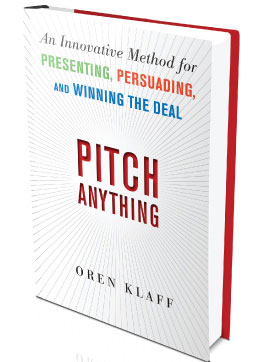What do you feel like when you enter a customer’s lobby? You know, those isolated areas where the admin or security guard asks you to show your I.D., makes you sign in a book and then tells you to have a seat while they call your contact to come get you. What does it feel like to you? Do you feel minimized or weakened? According to Oren Klaff, Author of Pitch Anything, that feeling you have is real, because the waiting room and the process behind it are designed to make you feel that way. Oren says, they are designed to put you in the “beta” position. That is, they are meant to subjugate you to your buyer or prospect and having you subjageted gives them power.
Avoiding becoming the “beta” is just one of the many unique and compelling elements of Oren Klaff’s book Pitch Anything.
 Pitch Anything is a compelling and entertaining book about the psychological components of the pitch. The pitch being the process of trying to get someone’s attention in order to get them to make a decision in your favor. At the core of the pitch is the idea there are two parts of the brain used in making a decision; the croc brain and the neocortex. Klaff argues that in order to have a successful pitch we have to get through the croc brain first. The croc brain is pretty simple. Everything is coded in one of these ways:
Pitch Anything is a compelling and entertaining book about the psychological components of the pitch. The pitch being the process of trying to get someone’s attention in order to get them to make a decision in your favor. At the core of the pitch is the idea there are two parts of the brain used in making a decision; the croc brain and the neocortex. Klaff argues that in order to have a successful pitch we have to get through the croc brain first. The croc brain is pretty simple. Everything is coded in one of these ways:
- Boring: Ignore it.
- Dangerous: Fight/Run
- Complicated: Radically summarize (causing a lot to be lost in the process) and pass it in severely truncated form.
What I enjoyed most about the framing and Pitch Anything was the social dynamic of pitching or selling. The secret sauce of the book is it’s ability to reshape your confidence and your mental state. As much as the book offers real approaches to improving the pitch, it taps into your own croc brain and fires up an emotional assessment of your pitching approach. You can’t help but ask yourself how often you lose the power frame, which almost always spells disaster. You’ll find yourself evaluating how often your pitches target the neocortex, which inevitably slows down the entire sales process. The neocortex is slow, it’s the analytical part of your brain and there is nothing fast or emotional with how it makes decisions. The book will have you questioning your place in the pitching world.
Pitch Anything get’s at your sense of self. It triggers self-discovery and gets you to ask yourself; am I a bad ass or a wimp? It gets you thinking about all the times you lost the power frame, how often you subjugated yourself to the buyer and how it may of cost you millions in sales and lost pitches over the years. Pitch Anything will have you evaluating every interaction and pitch you’ve ever had. It will have you asking; did I lose the power frame in that one? Should I have used the Analyst frame that time etc.?
BONUS:

